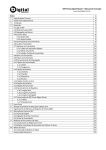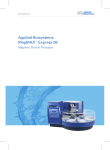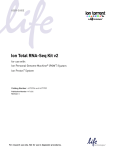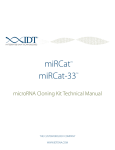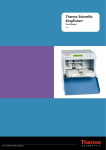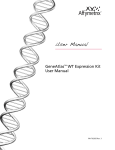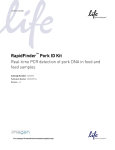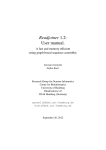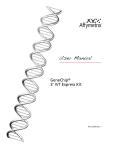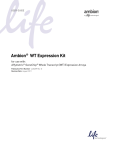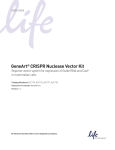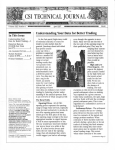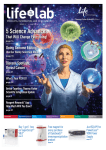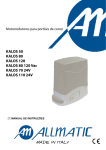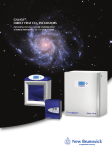Download Dynabeads® mRNA DIRECT™ Micro Kit User Guide
Transcript
USER GUIDE Dynabeads® mRNA DIRECT™ Micro Kit Catalog Number 61021 Revision 004 Revision Date 14 May 2012 For Research Use Only. Not for human or animal therapeutic or diagnostic use. For Research Use Only. Not for human or animal therapeutic or diagnostic use. The information in this guide is subject to change without notice. DISCLAIMER LIFE TECHNOLOGIES CORPORATION AND/OR ITS AFFILIATE(S) DISCLAIM ALL WARRANTIES WITH RESPECT TO THIS DOCUMENT, EXPRESSED OR IMPLIED, INCLUDING BUT NOT LIMITED TO THOSE OF MERCHANTABILITY, FITNESS FOR A PARTICULAR PURPOSE, OR NON-INFRINGEMENT. TO THE EXTENT ALLOWED BY LAW, IN NO EVENT SHALL LIFE TECHNOLOGIES AND/OR ITS AFFILIATE(S) BE LIABLE, WHETHER IN CONTRACT, TORT, WARRANTY, OR UNDER ANY STATUTE OR ON ANY OTHER BASIS FOR SPECIAL, INCIDENTAL, INDIRECT, PUNITIVE, MULTIPLE OR CONSEQUENTIAL DAMAGES IN CONNECTION WITH OR ARISING FROM THIS DOCUMENT, INCLUDING BUT NOT LIMITED TO THE USE THEREOF. NOTICE TO PURCHASER: LIMITED USE LABEL LICENSE: Research Use Only The purchase of this product conveys to the purchaser the limited, non-transferable right to use the purchased amount of the product only to perform internal research for the sole benefit of the purchaser. No right to resell this product or any of its components is conveyed expressly, by implication, or by estoppel. This product is for internal research purposes only and is not for use in commercial applications of any kind, including, without limitation, quality control and commercial services such as reporting the results of purchaser's activities for a fee or other form of consideration. For information on obtaining additional rights, please contact [email protected] or Out Licensing, Life Technologies, 5791 Van Allen Way, Carlsbad, California 92008. Manufactured by Life Technologies AS, Norway. Life Technologies AS complies with the Quality System Standards ISO 9001:2008 and ISO 13485:2003. TRADEMARKS The trademarks mentioned herein are the property of Life Technologies Corporation or their respective owners. Agilent is a registered trademark and Bioanalyzer is a trademark of Agilent Technologies, Inc. Adobe and Adobe Reader are registered trademarks of Adobe Systems, Inc. © 2012 Life Technologies Corporation. All rights reserved. Contents ■ CHAPTER 1 Product Information . . . . . . . . . . . . . . . . . . . . . . . . . . . . . . . . 5 Purpose of product . . . . . . . . . . . . . . . . . . . . . . . . . . . . . . . . . . . . . . . . . . . . . . . . . . . . . . . . . . . . . . . . . . . . 5 Product performance . . . . . . . . . . . . . . . . . . . . . . . . . . . . . . . . . . . . . . . . . . . . . . . . . . . . . . . . . . . . . . 6 Contents and storage . . . . . . . . . . . . . . . . . . . . . . . . . . . . . . . . . . . . . . . . . . . . . . . . . . . . . . . . . . . . . . . . . . 6 Storage and stability . . . . . . . . . . . . . . . . . . . . . . . . . . . . . . . . . . . . . . . . . . . . . . . . . . . . . . . . . . . . . . . 7 ■ CHAPTER 2 Direct mRNA Isolation from Microscale Samples from Cells or Tissues . . . . . . . . . . . . . . . . . . . . . . . . . . . . . . . . . . . . . . . . . . . . 8 Workflow . . . . . . . . . . . . . . . . . . . . . . . . . . . . . . . . . . . . . . . . . . . . . . . . . . . . . . . . . . . . . . . . . . . . . . . . . . . . . 8 Materials and equipment required but not provided . . . . . . . . . . . . . . . . . . . . . . . . . . . . . . . . . . . . . . . . 9 Prepare reagents and samples . . . . . . . . . . . . . . . . . . . . . . . . . . . . . . . . . . . . . . . . . . . . . . . . . . . . . . . . . . 9 Prepare buffers . . . . . . . . . . . . . . . . . . . . . . . . . . . . . . . . . . . . . . . . . . . . . . . . . . . . . . . . . . . . . . . . . . . 9 Wash Dynabeads® Oligo (dT)25 before use . . . . . . . . . . . . . . . . . . . . . . . . . . . . . . . . . . . . . . . . . . . . 9 Prepare samples . . . . . . . . . . . . . . . . . . . . . . . . . . . . . . . . . . . . . . . . . . . . . . . . . . . . . . . . . . . . . . . . . 10 mRNA isolation from cultured cells and cell suspensions . . . . . . . . . . . . . . . . . . . . . . . . . . . . . . . . . . 10 Before you begin . . . . . . . . . . . . . . . . . . . . . . . . . . . . . . . . . . . . . . . . . . . . . . . . . . . . . . . . . . . . . . . . . 10 Prepare lysate from cultured cells and cell suspensions . . . . . . . . . . . . . . . . . . . . . . . . . . . . . . 10 Isolate mRNA for PCR amplification . . . . . . . . . . . . . . . . . . . . . . . . . . . . . . . . . . . . . . . . . . . . . . . . 10 PCR amplification . . . . . . . . . . . . . . . . . . . . . . . . . . . . . . . . . . . . . . . . . . . . . . . . . . . . . . . . . . . . . . . . 11 mRNA isolation from tissues . . . . . . . . . . . . . . . . . . . . . . . . . . . . . . . . . . . . . . . . . . . . . . . . . . . . . . . . . . . 12 Before you begin . . . . . . . . . . . . . . . . . . . . . . . . . . . . . . . . . . . . . . . . . . . . . . . . . . . . . . . . . . . . . . . . . 12 Prepare lysate from plant and animal tissues . . . . . . . . . . . . . . . . . . . . . . . . . . . . . . . . . . . . . . . . 12 Isolate mRNA for PCR amplification . . . . . . . . . . . . . . . . . . . . . . . . . . . . . . . . . . . . . . . . . . . . . . . . 12 PCR amplification . . . . . . . . . . . . . . . . . . . . . . . . . . . . . . . . . . . . . . . . . . . . . . . . . . . . . . . . . . . . . . . . 13 mRNA isolation from tumor cells . . . . . . . . . . . . . . . . . . . . . . . . . . . . . . . . . . . . . . . . . . . . . . . . . . . . . . . 14 Before you begin . . . . . . . . . . . . . . . . . . . . . . . . . . . . . . . . . . . . . . . . . . . . . . . . . . . . . . . . . . . . . . . . . 14 Prepare lysate from tumor cells isolated from whole blood or MNC . . . . . . . . . . . . . . . . . . . . . 14 Isolate mRNA for PCR amplification . . . . . . . . . . . . . . . . . . . . . . . . . . . . . . . . . . . . . . . . . . . . . . . . 14 PCR amplification . . . . . . . . . . . . . . . . . . . . . . . . . . . . . . . . . . . . . . . . . . . . . . . . . . . . . . . . . . . . . . . . 15 ■ CHAPTER 3 mRNA Isolation from Purified Total RNA . . . . . . . . . . . 16 Workflow . . . . . . . . . . . . . . . . . . . . . . . . . . . . . . . . . . . . . . . . . . . . . . . . . . . . . . . . . . . . . . . . . . . . . . . . . . . . 16 Materials and equipment required but not provided . . . . . . . . . . . . . . . . . . . . . . . . . . . . . . . . . . . . . . . 17 mRNA isolation from >1–50 µg total RNA samples . . . . . . . . . . . . . . . . . . . . . . . . . . . . . . . . . . . . . . . . 17 Before you begin . . . . . . . . . . . . . . . . . . . . . . . . . . . . . . . . . . . . . . . . . . . . . . . . . . . . . . . . . . . . . . . . . 17 Wash the Dynabeads® Oligo (dT)25 . . . . . . . . . . . . . . . . . . . . . . . . . . . . . . . . . . . . . . . . . . . . . . . . . . 18 Dynabeads® mRNA DIRECT™ Micro Kit User Guide 3 Contents Prepare the total RNA sample(s) . . . . . . . . . . . . . . . . . . . . . . . . . . . . . . . . . . . . . . . . . . . . . . . . . . . 19 Perform two rounds of mRNA isolation in the same well . . . . . . . . . . . . . . . . . . . . . . . . . . . . . . 19 Assess the yield and size distribution of the mRNA . . . . . . . . . . . . . . . . . . . . . . . . . . . . . . . . . . . 22 mRNA isolation from 100 ng–1 µg total RNA samples . . . . . . . . . . . . . . . . . . . . . . . . . . . . . . . . . . . . . Before you begin . . . . . . . . . . . . . . . . . . . . . . . . . . . . . . . . . . . . . . . . . . . . . . . . . . . . . . . . . . . . . . . . . Wash the Dynabeads® Oligo (dT)25 . . . . . . . . . . . . . . . . . . . . . . . . . . . . . . . . . . . . . . . . . . . . . . . . . Prepare the total RNA sample(s) . . . . . . . . . . . . . . . . . . . . . . . . . . . . . . . . . . . . . . . . . . . . . . . . . . . Perform two rounds of mRNA isolation in the same well . . . . . . . . . . . . . . . . . . . . . . . . . . . . . . Next steps if using Ion Total RNA-Seq Kit v2 . . . . . . . . . . . . . . . . . . . . . . . . . . . . . . . . . . . . . . . . . ■ APPENDIX A 23 23 23 23 24 25 Guidelines and Troubleshooting . . . . . . . . . . . . . . . . . . . 26 Guidelines for best results . . . . . . . . . . . . . . . . . . . . . . . . . . . . . . . . . . . . . . . . . . . . . . . . . . . . . . . . . . . . . 26 Troubleshooting . . . . . . . . . . . . . . . . . . . . . . . . . . . . . . . . . . . . . . . . . . . . . . . . . . . . . . . . . . . . . . . . . . . . . . 27 ■ APPENDIX B Downstream Applications . . . . . . . . . . . . . . . . . . . . . . . . . 28 Solid-phase cDNA synthesis and one-tube reverse transcription PCR . . . . . . . . . . . . . . . . . . . . . . . 28 Construction of immobilized cDNA libraries for multiple PCR amplifications . . . . . . . . . . . . . . . . . 29 PCR amplification from a reusable solid-phase cDNA library . . . . . . . . . . . . . . . . . . . . . . . . . . . . . . . 29 RNA-Seq whole-transcriptome library preparation . . . . . . . . . . . . . . . . . . . . . . . . . . . . . . . . . . . . . . . 29 ■ APPENDIX C Ordering Information . . . . . . . . . . . . . . . . . . . . . . . . . . . . . 30 Other Dynabeads® Oligo (dT)25 products . . . . . . . . . . . . . . . . . . . . . . . . . . . . . . . . . . . . . . . . . . . . . . . . . 30 Total RNA and total RNA purification products . . . . . . . . . . . . . . . . . . . . . . . . . . . . . . . . . . . . . . . . . . . . 30 Reverse transcription for Real-Time PCR products . . . . . . . . . . . . . . . . . . . . . . . . . . . . . . . . . . . . . . . 31 Reverse transcription for cloning products . . . . . . . . . . . . . . . . . . . . . . . . . . . . . . . . . . . . . . . . . . . . . . . 31 Additional products mentioned in this user guide . . . . . . . . . . . . . . . . . . . . . . . . . . . . . . . . . . . . . . . . . 32 ■ APPENDIX D Safety . . . . . . . . . . . . . . . . . . . . . . . . . . . . . . . . . . . . . . . . . . 33 Chemical safety . . . . . . . . . . . . . . . . . . . . . . . . . . . . . . . . . . . . . . . . . . . . . . . . . . . . . . . . . . . . . . . . . . . . . . 34 Specific chemical handling . . . . . . . . . . . . . . . . . . . . . . . . . . . . . . . . . . . . . . . . . . . . . . . . . . . . . . . . 34 Biological hazard safety . . . . . . . . . . . . . . . . . . . . . . . . . . . . . . . . . . . . . . . . . . . . . . . . . . . . . . . . . . . . . . . 35 Documentation and Support . . . . . . . . . . . . . . . . . . . . . . . . . . . . . . . . . . . . . 36 Related documentation . . . . . . . . . . . . . . . . . . . . . . . . . . . . . . . . . . . . . . . . . . . . . . . . . . . . . . . . . . . . . . . 36 Obtaining SDSs . . . . . . . . . . . . . . . . . . . . . . . . . . . . . . . . . . . . . . . . . . . . . . . . . . . . . . . . . . . . . . . . . . . . . . 36 Obtaining Certificates of Analysis . . . . . . . . . . . . . . . . . . . . . . . . . . . . . . . . . . . . . . . . . . . . . . . . . . . . . . . 36 Obtaining support . . . . . . . . . . . . . . . . . . . . . . . . . . . . . . . . . . . . . . . . . . . . . . . . . . . . . . . . . . . . . . . . . . . . 37 Limited Product Warranty . . . . . . . . . . . . . . . . . . . . . . . . . . . . . . . . . . . . . . . . . . . . . . . . . . . . . . . . . . . . . 37 Bibliography . . . . . . . . . . . . . . . . . . . . . . . . . . . . . . . . . . . . . . . . . . . . . . . . . . . 38 4 Dynabeads® mRNA DIRECT™ Micro Kit User Guide 1 Product Information IMPORTANT! Before using this product, read and understand the information in Appendix D, “Safety” on page 33. Purpose of product The Dynabeads® mRNA DIRECT™ Micro Kit is designed for simple and rapid isolation of pure, intact polyadenylated [poly(A)] mRNA. The kit isolates highly purified and intact mRNA directly from microscale samples from cells or tissues and from purified total RNA samples. The kit contains Dynabeads® Oligo (dT)25, uniform and superparamagnetic beads with oligo (dT) sequences covalently bound to their surface. The isolation protocol relies on base pairing between the poly(A) residues at the 3’ end of most mRNA, and the oligo (dT)25 residues covalently coupled to the surface of the Dynabeads®. Other RNA species lacking a poly(A) tail do not hybridize to the beads and are readily washed away. When using the kit to isolate mRNA directly from microscale samples from cells or tissues, isolation is completed in only 15 minutes in a single tube, without the need to prepare total RNA, or to perform any other purifications steps. Use the isolated mRNA directly for reverse transcription into cDNA, followed by transcript amplification by PCR. The bead-bound oligo (dT) is used both to capture the mRNA and as a primer for reverse transcriptase synthesis into first strand cDNA. The isolated mRNA does not need to be eluted from the beads, but can instead be used directly for reverse transcription and PCR amplification. The combination of direct mRNA isolation and one-tube reverse transcription allows for fast and reliable PCR detection. When using the kit to isolate mRNA from purified total RNA, two rounds of mRNA isolation are completed in less than 30 minutes. The resulting isolated mRNA contains very low ribosomal RNA content, which allows for the most accurate measurement of coding transcripts. Samples are prepared in a plate to enable parallel processing of multiple samples. The resulting isolated mRNA is ready for any downstream application and has been validated for RNA-Seq whole transcriptome library preparation using the Ion Total RNA-Seq Kit v2. Note: All protocols in this user guide can be used to obtain a final product of eluted mRNA or a Dynabeads®-mRNA complex, depending on the requirements for the downstream application. Dynabeads® mRNA DIRECT™ Micro Kit User Guide 5 1 Chapter 1 Product Information Contents and storage Product performance The Dynabeads® mRNA DIRECT™ Micro Kit provides enough reagents for: • 100 microscale direct mRNA isolations from up to 2.5 × 104 mononuclear cells, up to 1 × 104 cultured cells, or up to 5 mg tissue (depending on the tissue type) • 100 microscale or 20 large scale (50 µg) mRNA isolations from purified total RNA A strong RNase inhibiting agent and stringent hybridization and washing buffers ensure isolation of intact, high-purity mRNA even from crude samples rich in RNases. Enzymatic downstream applications are not inhibited by the presence of the beads. 1 mL of Dynabeads® Oligo (dT)25 can isolate 10 µg of mRNA. The specific yield will depend on the tissue, cell, or total RNA type. Contents and storage The Dynabeads® mRNA DIRECT™ Micro Kit (Cat. no. 61021) contains the following components: Contents Dynabeads® Oligo (dT)25 (2 × 1 mL) Description Storage Conditions Supplied as approximately 5 mg/mL bead-suspension in phosphate-buffered saline (PBS) pH 7.4, containing 0.02% sodium azide (NaN3) as a preservative: Store at 2°C to 8°C. After opening, avoid bacterial contamination. • 137 mM NaCl • 2.7 mM KCl • 4.3 mM Na2HPO4 × 7H2O • 1.4 mM KH2PO4 • 0.02% NaN3 Lysis/Binding Buffer (15 mL) • 100 mM Tris-HCl, pH 7.5 • 500 mM LiCl • 10 mM EDTA, pH 8.0 • 1% LiDS • 5 mM dithiothreitol (DTT) Washing Buffer A (30 mL) • 10 mM Tris-HCl, pH 7.5 • 0.15 M LiCl • 1 mM EDTA • 0.1% LiDS Washing Buffer B (30 mL) • 10 mM Tris-HCl, pH 7.5 • 0.15 M LiCl • 1 mM EDTA 10 mM Tris-HCl† (15 mL) 10 mM Tris-HCl, pH 7.5 † The protocols in Chapter 3, “mRNA Isolation from Purified Total RNA” on page 16 use nuclease-free water for elution rather than the 10 mM Tris-HCl Elution Buffer provided with the kit. 6 Dynabeads® mRNA DIRECT™ Micro Kit User Guide Chapter 1 Product Information Contents and storage Storage and stability 1 • The components in the kit are guaranteed stable until the expiry date stated on the label when stored unopened at 2°C to 8°C. • All reagents used are of analytical grade and RNase-free. • The Dynabeads® suspension and the buffers provided in the kit are ribonucleasefree and tested for optimal performance. • Dynabeads® Oligo (dT)25 are stable in a pH range of 4-13. • Dynabeads® Oligo (dT)25 may be frozen in the buffer they are supplied in. Avoid repeated freezing and thawing. Do not store or freeze the Dynabeads® in distilled water. • Store the vials of Dynabeads® upright to avoid drying of the beads. If the Dynabeads® have dried in the vial, resuspend the beads in the buffer they are supplied in by placing the vial on a mixer overnight (4°C). • If the buffers precipitate, warm to room temperature and mix until the precipitate dissolves. Dynabeads® mRNA DIRECT™ Micro Kit User Guide 7 2 Direct mRNA Isolation from Microscale Samples from Cells or Tissues ■ Workflow. . . . . . . . . . . . . . . . . . . . . . . . . . . . . . . . . . . . . . . . . . . . . . . . . . . . . . . . . . . . . . 8 ■ Materials and equipment required but not provided . . . . . . . . . . . . . . . . . . . . . . . . 9 ■ Prepare reagents and samples . . . . . . . . . . . . . . . . . . . . . . . . . . . . . . . . . . . . . . . . . . . . 9 ■ mRNA isolation from cultured cells and cell suspensions . . . . . . . . . . . . . . . . . . . 10 ■ mRNA isolation from tissues . . . . . . . . . . . . . . . . . . . . . . . . . . . . . . . . . . . . . . . . . . . . 12 ■ mRNA isolation from tumor cells . . . . . . . . . . . . . . . . . . . . . . . . . . . . . . . . . . . . . . . . 14 Workflow Prepare reagents and samples Prepare lysate Isolate mRNA for PCR amplification Prepare RNA for binding Bind mRNA to the Dynabeads® Wash the mRNA Resuspend mRNA and store on ice for downstream applications Place mRNA on magnet and remove supernatant 8 Dynabeads® mRNA DIRECT™ Micro Kit User Guide Chapter 2 Direct mRNA Isolation from Microscale Samples from Cells or Tissues Materials and equipment required but not provided 2 Materials and equipment required but not provided All reagents used should be analytical grade and RNase-free. Item DynaMag™-2 Magnet or other appropriate magnet Source Cat.no. Life Technologies 12321D Pipettors and sterile, RNAse-free pipette tips Major laboratory suppliers (MLS) — Sterile, RNase-free microcentrifuge tubes MLS — HulaMixer™ Sample Mixer Life Technologies 15920D See www.lifetechnologies.com/magnets for magnet recommendations. When working with tissue samples, the following materials are also required: Liquid nitrogen MLS — Manual tissue grinder MLS — Syringe and needle (see “Troubleshooting” on page 27) MLS — When working with tumor cell samples, the following is also required: Dynabeads® Epithelial Enrich Life Technologies 16102 Prepare reagents and samples IMPORTANT! We strongly recommend that you read this section and “Guidelines for best results” on page 26 before starting your mRNA isolation protocol. Prepare buffers • Bring all buffers except the 10 mM Tris-HCl to room temperature before use. Store the 10 mM Tris-HCl on ice or at 2°C to 8°C before use. • Confirm that the Lysis/Binding Buffer has not precipitated. If any precipitation is observed, warm to room temperature and shake to dissolve. Wash Dynabeads® Oligo (dT)25 before use 1. Resuspend the Dynabeads® Oligo (dT)25 in the tube (either vortex for >30 seconds, or tilt and rotate for 5 minutes). Note: If the Dynabeads® Oligo (dT)25 becomes dried out, resuspend the beads in the buffer they are supplied in by placing the vial on a roller or equivalent overnight (2°C to 8°C) to restore their complete functionality. 2. Transfer the appropriate volume of Dynabeads® Oligo (dT)25 (use 20 µL Dynabeads® per mRNA isolation) from the stock tube suspension to an RNasefree microcentrifuge tube. 3. Add an equivalent volume of Lysis/Binding Buffer (20 µL per mRNA isolation, but not less than 1 mL) to the microcentrifuge tube, then mix. Dynabeads® mRNA DIRECT™ Micro Kit User Guide 9 2 Chapter 2 Direct mRNA Isolation from Microscale Samples from Cells or Tissues mRNA isolation from cultured cells and cell suspensions 4. Place the tube on a magnet for 1 minute, then remove and discard the supernatant. 5. Remove the tube from the magnet, then resuspend the beads in the same volume of Lysis/Binding Buffer that you used in step 2c (20 µL per mRNA isolation). Aliquot 20 µL suspension to each sample tube. Prepare samples • If you are preparing reverse transcription reactions: Prepare your reverse transcription PCR mix before the mRNA isolation and keep on ice. • If you are working with cells previously isolated using magnetic separation: Make sure that all Dynabeads® are removed from the lysate before adding Dynabeads® Oligo (dT)25 (see “mRNA isolation from tumor cells” on page 14). • If you are working with frozen cells: Perform a rapid lysis in Lysis/Binding buffer. This is critical for obtaining undegraded mRNA. Avoid thawing of frozen material before lysis. mRNA isolation from cultured cells and cell suspensions IMPORTANT! To prevent RNA degradation by RNase contamination, use gloves and change them frequently. Note: To isolate mRNA from primary tumor cells from whole blood or bone marrow tissues, see “mRNA isolation from tumor cells” on page 14. Before you begin • Follow the instructions in “Prepare reagents and samples” on page 9. • Read “Guidelines for best results” on page 26. Note: We recommend that you prepare the reverse transcription PCR mix before starting the mRNA isolation protocol. Prepare lysate from cultured cells and cell suspensions This protocol is recommended for samples containing up to 1 × 104 cultured cells or up to 2.5 × 104 mononuclear cells. 1. Wash the cell suspension in phosphate-buffered saline (PBS) prior to preparing a cell pellet by centrifugation. The cell pellet can be used immediately, or frozen in liquid nitrogen and stored at –80°C for later use. 2. Add 100 µL Lysis/Binding Buffer to the fresh/frozen cell pellet. Perform a repeated passage of the solution through a pipette tip to obtain complete lysis. The lysate may be frozen (–80°C) and stored for later use. Isolate mRNA for PCR amplification 1. Transfer the clear lysate to the tube containing 20 µL pre-washed Dynabeads® Oligo (dT)25 (prepared according to “Wash Dynabeads® Oligo (dT)25 before use” on page 9). 2. Pipet up and down 2–3 times to mix. 3. Place the tube on a sample mixer or roller for 5 minutes at room temperature to allow the mRNA to anneal to the Dynabeads® with continuous rotation. 10 Dynabeads® mRNA DIRECT™ Micro Kit User Guide Chapter 2 Direct mRNA Isolation from Microscale Samples from Cells or Tissues mRNA isolation from cultured cells and cell suspensions 2 4. Place the sample tube on the magnet for 1 minute, then discard the supernatant. 5. Remove the sample tube from the magnet and resuspend the Dynabeads®-mRNA complex in 100 µL Washing Buffer A by careful pipetting. 6. Place the sample tube on the magnet for 1 minute, then discard the supernatant. 7. Repeat steps 5–6 once. 8. Resuspend the Dynabeads®-mRNA complex in 100 µL Washing Buffer B. 9. Transfer the suspension to a new tube. 10. Place the new sample tube on the magnet for 1 minute, then discard the supernatant. 11. Resuspend the Dynabeads®-mRNA complex in 100 µL Washing Buffer B. 12. Place the sample tube on the magnet for 1 minute, then discard the supernatant. 13. Remove the sample tube from the magnet and resuspend the Dynabeads®-mRNA complex in 100 µL of ice-cold 10 mM Tris-HCl. 14. Store the sample tube on ice for immediate use in PCR amplification. Note: We recommend that you immediately use the Dynabeads®–mRNA complex for reverse transcription. If storage is needed, elute the mRNA off the beads and freeze the mRNA-containing supernatant. When storing mRNA, it is critical that no RNase is present in your sample. If elution of mRNA is necessary, add 10-20 µL 10 mM Tris-HCl and incubate at 65°C to 80°C for 2 minutes. Place the tube on the magnet and immediately transfer the supernatant to a new microcentrifuge tube. The eluate may be used immediately for reverse transcription or store for up to two weeks at –80°C. PCR amplification 1. Immediately before adding the reverse transcription PCR mix, place the tube containing the Dynabeads®-mRNA complex on the magnet for 1 minute, then discard the supernatant. 2. Add reverse transcription PCR reaction mix: • For one-tube PCR: Resuspend the Dynabeads®-mRNA complex in 50 µL reverse transcription PCR mix and transfer to the PCR tube. • For two-step PCR: Resuspend the Dynabeads®-mRNA complex in the reverse transcription PCR reaction mix according to the manufacturer’s recommendation. 3. Perform cDNA synthesis as recommended by the manufacturer of the reverse transcriptase. When using a thermostable reverse transcriptase and the beadbound oligo (dT) as primer for first strand cDNA synthesis, an initial incubation at 50°C for 5 minutes is necessary before proceeding at the recommended temperature. For additional guidelines on using the isolated mRNA in downstream applications, see Appendix B on page 28. Dynabeads® mRNA DIRECT™ Micro Kit User Guide 11 2 Chapter 2 Direct mRNA Isolation from Microscale Samples from Cells or Tissues mRNA isolation from tissues mRNA isolation from tissues IMPORTANT! To prevent RNA degradation by RNase contamination, use gloves and change them frequently. Before you begin • Follow the instructions in “Prepare reagents and samples” on page 9. • Read “Guidelines for best results” on page 26. Note: We recommend that you prepare the reverse transcription PCR mix before starting the mRNA isolation protocol. Prepare lysate from plant and animal tissues 1. Grind frozen tissue sample (up to 5 mg depending on the tissue type) in a microcentrifuge tube, using a manual tissue grinder. Work quickly. Note: Aliquot (weigh) the animal or plant tissue while frozen, to avoid mRNA degradation. Use the specified amount of tissue, since an excess of tissue will reduce the mRNA yield and purity. 2. Keep the sample frozen by dipping the sample tube in liquid nitrogen. 3. Add 100 µL Lysis/Binding Buffer and thaw sample while continuing to grind until complete lysis is obtained (approximately 1–2 minutes). A rapid lysis in the Lysis/Binding Buffer is critical to obtain undegraded mRNA. If the raw extract is noticeably viscous a shearing step might be beneficial (see “Troubleshooting” on page 27). 4. Centrifuge the lysate for 30–60 seconds in a microcentrifuge to remove debris. The lysate can be frozen and stored at –80°C for later use. Isolate mRNA for PCR amplification 1. Combine the 100 µL lysate with the 20 µL prewashed Dynabeads® Oligo (dT)25 (prepared according to “Wash Dynabeads® Oligo (dT)25 before use” on page 9). 2. Pipet up and down 2–3 times to mix. 3. Place the tube on a sample mixer or roller for 5 minutes at room temperature to allow the mRNA to anneal to the Dynabeads® with continuous rotation. 4. Place the sample tube on the magnet for 1 minute, then discard the supernatant. 5. Remove the sample tube from the magnet and resuspend the Dynabeads®-mRNA complex in 100 µL Washing Buffer A by careful pipetting. 6. Place the sample tube on the magnet for 1 minute, then discard the supernatant. 7. Repeat steps 5–6 once. 8. Resuspend the Dynabeads®-mRNA complex in 100 µL Washing Buffer B. 9. Transfer the suspension to a new tube. 10. Place the new sample tube on the magnet for 1 minute, then discard the supernatant. 11. Resuspend the Dynabeads®-mRNA complex in 100 µL Washing Buffer B. 12. Place the sample tube on the magnet for 1 minute, then discard the supernatant. 12 Dynabeads® mRNA DIRECT™ Micro Kit User Guide Chapter 2 Direct mRNA Isolation from Microscale Samples from Cells or Tissues mRNA isolation from tissues 2 13. Remove the sample tube from the magnet and resuspend the Dynabeads®-mRNA complex in 100 µL of ice-cold 10 mM Tris-HCl. 14. Store the sample tube on ice for immediate use in PCR amplification. Note: We recommend that you immediately use the Dynabeads®–mRNA complex for reverse transcription. If storage is needed, elute the mRNA off the beads and freeze the mRNA-containing supernatant. When storing mRNA, it is critical that no RNase is present in your sample. If elution of mRNA is necessary, add 10-20 µL 10 mM Tris-HCl and incubate at 65°C to 80°C for 2 minutes. Place the tube on the magnet and immediately transfer the supernatant to a new microcentrifuge tube. The eluate may be used immediately for reverse transcription or store for up to two weeks at –80°C. PCR amplification 1. Immediately before adding the reverse transcription PCR mix, place the tube containing the Dynabeads®-mRNA complex on the magnet for 1 minute, then discard the supernatant. 2. Add reverse transcription PCR reaction mix: • For one-tube PCR: Resuspend the Dynabeads®-mRNA complex in 50 µL reverse transcription PCR mix and transfer to the PCR tube. • For two-step PCR: Resuspend the Dynabeads®-mRNA complex in the reverse transcription PCR reaction mix according to the manufacturer’s recommendation. 3. Perform cDNA synthesis as recommended by the manufacturer of the reverse transcriptase. When using a thermostable reverse transcriptase and the beadbound oligo (dT) as primer for first strand cDNA synthesis, an initial incubation at 50°C for 5 minutes is necessary before proceeding at the recommended temperature. For additional guidelines on using the isolated mRNA in downstream applications, see Appendix B on page 28. Dynabeads® mRNA DIRECT™ Micro Kit User Guide 13 2 Chapter 2 Direct mRNA Isolation from Microscale Samples from Cells or Tissues mRNA isolation from tumor cells mRNA isolation from tumor cells IMPORTANT! To prevent RNA degradation by RNase contamination, use gloves and change them frequently. Dynabeads® Epithelial Enrich (coated with the monoclonal antibody BerEP4 against the human epithelial antigen [HEA]) enriches epithelial tumor cells from blood or MNC. 5 mL anticoagulated whole blood samples or mononuclear cells (MNC) at a concentration of 1–2 × 107 cells/mL are mixed with the Dynabeads® Epithelial Enrich. The cells are isolated and purified by using a magnet, and the cells can be directly lysed while still on the beads. Isolate mRNA as described in the following procedure. The isolated mRNA can also be used in PCR for other genes. Before you begin • Follow the instructions in “Prepare reagents and samples” on page 9. • Read “Guidelines for best results” on page 26. Note: We recommend that you prepare the reverse transcription PCR mix before starting the mRNA isolation protocol. Prepare lysate from tumor cells isolated from whole blood or MNC 1. Follow the protocol for positive isolation of tumor cells from whole blood or MNC using Dynabeads® Epithelial Enrich. 2. After adding the final washing solution, transfer the bead suspension to a microcentrifuge tube. Keep the Dynabeads®-cell complex on ice for immediate mRNA isolation and PCR. 3. Immediately before use, place the sample tube on the magnet for 2-3 minutes and remove supernatant. 4. Lyse the cells by resuspending the Dynabeads®-cell complex in 100 µL Lysis/ Binding Buffer. 5. Pipet up and down 2–3 times to mix. Isolate mRNA for PCR amplification 1. Place the sample tube with the lysed cells on the magnet for 2 minutes. 2. Transfer the supernatant (clear lysate containing released mRNA) to a microcentrifuge tube containing 20 µL pre-washed Dynabeads® Oligo (dT)25 (prepared according to “Wash Dynabeads® Oligo (dT)25 before use” on page 9). 3. Pipet up and down 2–3 times to mix. 4. Place the tube on a sample mixer or roller for 5 minutes at room temperature to allow the mRNA to anneal to the Dynabeads® with continuous rotation. 5. Place the sample tube on the magnet for 2 minutes, then discard the supernatant. 6. Remove the sample tube from the magnet and resuspend the Dynabeads®-mRNA complex in 100 µL Washing Buffer A by careful pipetting. 7. Place the sample tube on the magnet for 1 minute, then discard the supernatant. 8. Repeat steps 6–7 once. 9. Resuspend the Dynabeads®-mRNA complex in 100 µL Washing Buffer B. 14 Dynabeads® mRNA DIRECT™ Micro Kit User Guide Chapter 2 Direct mRNA Isolation from Microscale Samples from Cells or Tissues mRNA isolation from tumor cells 2 10. Transfer the suspension to a new tube. 11. Place the new sample tube on the magnet for 1 minute, then discard the supernatant. 12. Resuspend the Dynabeads®-mRNA complex in 100 µL Washing Buffer B. 13. Place the sample tube on the magnet for 1 minute, then discard the supernatant. 14. Remove the sample tube from the magnet and resuspend the Dynabeads®-mRNA complex in 100 µL of ice-cold 10 mM Tris-HCl. 15. Store the sample tube on ice for immediate use in PCR amplification. Note: We recommend that you immediately use the Dynabeads®–mRNA complex for reverse transcription. If storage is needed, elute the mRNA off the beads and freeze the mRNA-containing supernatant. When storing mRNA, it is critical that no RNase is present in your sample. If elution of mRNA is necessary, add 10-20 µL 10 mM Tris-HCl and incubate at 65°C to 80°C for 2 minutes. Place the tube on the magnet and immediately transfer the supernatant to a new microcentrifuge tube. The eluate may be used immediately for reverse transcription or store for up to two weeks at –80°C. PCR amplification 1. Immediately before adding the reverse transcription PCR mix, place the tube containing the Dynabeads®-mRNA complex on the magnet for 1 minute, then discard the supernatant. 2. Add reverse transcription PCR reaction mix: • For one-tube PCR: Resuspend the Dynabeads®-mRNA complex in 50 µL reverse transcription PCR mix and transfer to the PCR tube. • For two-step PCR: Resuspend the Dynabeads®-mRNA complex in the reverse transcription PCR reaction mix according to the manufacturer’s recommendation. 3. Perform cDNA synthesis as recommended by the manufacturer of the reverse transcriptase. When using a thermostable reverse transcriptase and the beadbound oligo (dT) as primer for first strand cDNA synthesis, an initial incubation at 50°C for 5 minutes is necessary before proceeding at the recommended temperature. For additional guidelines on using the isolated mRNA in downstream applications, see Appendix B on page 28. Dynabeads® mRNA DIRECT™ Micro Kit User Guide 15 3 mRNA Isolation from Purified Total RNA ■ Workflow. . . . . . . . . . . . . . . . . . . . . . . . . . . . . . . . . . . . . . . . . . . . . . . . . . . . . . . . . . . . . 16 ■ Materials and equipment required but not provided . . . . . . . . . . . . . . . . . . . . . . . 17 ■ mRNA isolation from >1–50 µg total RNA samples. . . . . . . . . . . . . . . . . . . . . . . . . 17 ■ mRNA isolation from 100 ng–1 µg total RNA samples . . . . . . . . . . . . . . . . . . . . . . 23 Workflow Wash the Dynabeads® Oligo (dT)25 Prepare the total RNA sample(s) Perform two rounds of mRNA isolation in the same well Prepare the RNA for binding Round 1: Bind the mRNA to the Dynabeads® Wash the mRNA Elute the mRNA Round 2: Re-bind the mRNA to the Dynabeads® Wash the mRNA Elute the mRNA 16 Dynabeads® mRNA DIRECT™ Micro Kit User Guide Chapter 3 mRNA Isolation from Purified Total RNA Materials and equipment required but not provided 3 Materials and equipment required but not provided Item Source Cat.no. Nuclease-free water Life Technologies AM9938 (Optional) Exfold ERCC Spike-In Mix Life Technologies 4456739 or or ERCC RNA Spike-In Mix 4456740 Magnetic Stand-96 Life Technologies AM10027 or or Magnetic-Ring Stand (96 Well) AM10050 or or DynaMag™-2 Magnet 12321D Pipettors and RNAse-free pipette tips Major laboratory suppliers (MLS) — 1.2-mL 96-well U-bottom plate MLS — (Optional) Non-Stick RNase-free Microfuge Tubes, 1.5 mL, 250 Life Technologies AM12450 Heat block and/or incubator MLS — mRNA isolation from >1–50 µg total RNA samples Before you begin • Read “Guidelines for best results” on page 26. • Prepare the Ion Total RNA-Seq Kit v2 reagents as directed in the Ion Total RNA-Seq Kit v2 User Guide (Pub. no. 4476286) before beginning this mRNA isolation protocol. • Bring all the Dynabeads® mRNA DIRECT™ Micro Kit reagents to room temperature (except the 10 mM Tris-HCl, which is not used in this protocol) • Confirm that the Lysis/Binding Buffer has not precipitated. If any precipitation is observed, warm to room temperature and shake to dissolve. • Warm 180 µL nuclease-free water per sample to 80°C. • Set a heat block or water bath to 70°C. Dynabeads® mRNA DIRECT™ Micro Kit User Guide 17 3 Chapter 3 mRNA Isolation from Purified Total RNA mRNA isolation from >1–50 µg total RNA samples Wash the Dynabeads® Oligo (dT)25 Note: Keep the Dynabeads® Oligo (dT)25 in liquid suspension during handling and storage to avoid reduced performance. 1. Vortex the Dynabeads® Oligo (dT)25 thoroughly to resuspend. 2. Pipet the appropriate volume of beads for your total RNA input into a new 1.5-mL tube or 1.2-mL 96-well U-bottom plate. Note: Include 5–10% excess volume for pipetting losses. For example, for 6 samples of 5 µg total RNA input, add 6 x 30 µL x 1.05 ≈ 190 µL of beads to the tube. Total RNA input Volume per sample Dynabeads® Oligo (dT)25 1–8 µg 30 µL >8–20 µg 50 µL >20–50 µg 100 µL 3. Place the tube or plate onto the appropriate magnetic stand, then allow the suspension to clear. 4. Aspirate and discard the clear supernatant without disturbing the beads. 5. Remove the tube or plate from the magnetic stand, then add an equivalent volume of fresh Lysis/Binding Buffer to the beads. 6. Vortex to resuspend the beads, then quick-spin to bring the beads to the bottom of the tube. The mixture should appear homogeneous. 18 Dynabeads® mRNA DIRECT™ Micro Kit User Guide Chapter 3 mRNA Isolation from Purified Total RNA mRNA isolation from >1–50 µg total RNA samples Prepare the total RNA sample(s) 3 Note: Use the highest quality total RNA possible as your starting material. Ideally, use RNA with an RNA integrity number (RIN) greater than 7. Use FirstChoice® Total RNA for high-quality, intact RNA isolated from a variety of sources, or see Appendix C, “Ordering Information” on page 30 for a list of appropriate total RNA purification products. Quantitate the amount of RNA in the sample using a Qubit® Fluorometer or NanoDrop® Spectrophotometer. 1. Dilute the total RNA sample in nuclease-free water to bring the sample to the final volume shown in the following table. Final RNA sample volume if using Spike-In Mix† Final RNA sample volume if not using Spike-In Mix 1–8 µg 150 µL – volume Spike-In Mix from table in step 2 150 µL >8–50 µg 300 µL – volume Spike-In Mix from table in step 2 300 µL Total RNA input † If you will add spike-in control mix (see next step), reduce the final RNA sample volume to allow for the appropriate volume of spike-in mix. For example, for 5 µg Total RNA input, bring the sample volume to 149 µL to allow for the addition of 1 µL spike-in mix in the next step. 2. (Recommended for gene expression experiments) Add an ERCC Spike-In Control Mix to the diluted total RNA sample. See the ERCC RNA Spike-In Control Mixes User Guide (Part no. 4455352) for mix selection and sample preparation procedures. The following chart indicates the correct dilution of ERCC to be added to the total RNA sample based on input. Total RNA input Volume of Spike-In Mix 1 or Mix 2 (dilution)† 1 µg 2 µL (1:100) 5 µg 1 µL (1:10) 10 µg 1 µL (1:5) 20 µg 2 µL (1:5) 30 µg 3 µL (1:5) 40 µg 4 µL (1:5) 50 µg 1 µL † ERCC RNA Spike-In Mix 1, ExFold Spike-In Mix 1, or ExFold Spike-In Mix 2 Perform two rounds of mRNA isolation in the same well 1. Prepare the RNA for binding: a. Heat the total RNA at 70°C for 2 minutes. b. Add an equal volume of Lysis/Binding Buffer to each volume of prepared total RNA sample, mix well, then quick-spin the samples. 2. Bind the mRNA to the Dynabeads®: a. Pipet the appropriate volume of washed Dynabeads® Oligo (dT)25 into a new well of the 1.2-mL 96-well plate. b. Transfer the heat-denatured RNA mixture to each well that contains Dynabeads® Oligo (dT)25. Dynabeads® mRNA DIRECT™ Micro Kit User Guide 19 3 Chapter 3 mRNA Isolation from Purified Total RNA mRNA isolation from >1–50 µg total RNA samples c. Pipet the mixture up and down 10 times, then incubate at room temperature for 5 minutes. The mixture should appear homogeneous. d. Place the plate on the Magnetic Stand-96. After the solution clears, remove and discard the supernatant without disturbing the pellet. 3. Wash the RNA: IMPORTANT! LiDS, a component of the Lysis/Binding and Washing A Buffers, is a strong inhibitor of enzymatic reactions. To minimize LiDS carryover: · Always use Washing Buffer A first, followed by Washing Buffer B. Washing Buffer B does not contain LiDS. · Thoroughly resuspend the beads/mRNA complex during the wash steps. a. Remove the plate from the Magnetic Stand-96. Add the appropriate amount of Washing Buffer A to each well, then pipet up and down 10 times. Total RNA input Washing Buffer A volume 1–8 µg 200 µL >8–50 µg 600 µL The mixture should appear homogeneous. b. Place the plate on the Magnetic Stand-96. After the solution clears, remove and discard the supernatant without disturbing the pellet. c. Remove the plate from the Magnetic Stand-96. Add 300 µL of Washing Buffer B to each well, then pipet up and down 10 times. The mixture should appear homogeneous. d. Place the plate on the Magnetic Stand-96. After the solution clears, remove and discard the supernatant without disturbing the pellet. IMPORTANT! Remove as much Washing Buffer B as possible without disturbing the pellet before you elute the samples. 4. Elute the mRNA: a. Remove the plate from Magnetic Stand-96. Add the specified volume of warmed (80°C) nuclease-free water to each well, pipet up and down 10 times to resuspend the beads in the nuclease-free water, then let sit 30 seconds at room temperature. 20 Total RNA input Volume warmed nuclease-free water to add per sample 1–20 µg 50 µL >20–50 µg 90 µL Dynabeads® mRNA DIRECT™ Micro Kit User Guide Chapter 3 mRNA Isolation from Purified Total RNA mRNA isolation from >1–50 µg total RNA samples 3 5. Re-bind the mRNA to the Dynabeads®: a. Add an equal volume of Lysis/Binding Buffer to each well, then pipet up and down 10 times. b. Incubate at room temperature for 5 minutes. The mixture should appear homogeneous. c. Place the plate on the Magnetic Stand-96. After the solution clears, remove and discard the supernatant without disturbing the pellet. 6. Repeat step 3 to wash the RNA. 7. Elute the mRNA: a. Remove the plate from the Magnetic Stand-96, then add the specified volume of the pre-heated (80°C) nuclease-free water to each well. Total RNA input Volume warmed nuclease-free water to add per sample 1–8 µg 10 µL >8–20 µg 10–15 µL >20–50 µg 20–30 µL b. Tap the plate to resuspend the beads in the nuclease-free water, then let sit 30 seconds at room temperature. If the solution appear homogenous, continue to the next step. If not, pipet to resuspend the beads before continuing to the next step. c. Place the plate on the Magnetic Stand-96. After the solution clears, transfer the supernatant containing the mRNA to a new tube without disturbing the pellet. Store the isolated mRNA on ice for immediate use, or store for up to two weeks at –80°C. For guidelines on using the isolated mRNA in downstream applications, see Appendix B on page 28. Dynabeads® mRNA DIRECT™ Micro Kit User Guide 21 3 Chapter 3 mRNA Isolation from Purified Total RNA mRNA isolation from >1–50 µg total RNA samples Assess the yield and size distribution of the mRNA Assess the yield and size distribution of the mRNA using the appropriate method for your initial sample input: Total RNA initial sample input ≥8 µg Recommended method 1. Quantitate the yield of the mRNA using the Qubit® RNA Assay Kit (Cat. no. Q32852) with a Qubit® Fluorometer. Refer to Qubit® RNA Assay Kits Manual (Man. no. MAN0002327) or the Qubit® 2.0 Fluorometer User Manual (Man. no. MAN0003231) for instructions. Note: You can use a NanoDrop® Spectrophotometer in place of the Qubit® RNA Assay Kit and Qubit® Fluorometer. For increased accuracy, we recommend that you quantitate the RNA concentration using the Qubit RNA Assay Kit with the Qubit Fluorometer. 2. Assess the quality of the mRNA: a. Run 1 µL of the sample on an Agilent® 2100 Bioanalyzer™ instrument with the Agilent® RNA 6000 Nano Kit. Follow the manufacturer’s instructions for performing the assay. b. Using the 2100 expert software, review the percent of 18s and 28s present in the sample. Note: For instructions on how to review the size distribution, refer to the Agilent® 2100 Bioanalyzer™ Expert User’s Guide. 1–8 µg Run 1 µL of the collected sample on an Agilent® 2100 Bioanalyzer™ instrument using the Agilent® RNA 6000 Pico Kit. Follow the manufacturer’s instructions to perform the assay. Do not further quantitate your sample. Note: For instructions on how to review the size distribution, refer to the Agilent® 2100 Bioanalyzer™ Expert User’s Guide. 22 Dynabeads® mRNA DIRECT™ Micro Kit User Guide Chapter 3 mRNA Isolation from Purified Total RNA mRNA isolation from 100 ng–1 µg total RNA samples 3 mRNA isolation from 100 ng–1 µg total RNA samples Before you begin • Read “Guidelines for best results” on page 26. • If preparing RNA-Seq whole transcriptome libraries from the mRNA, prepare the Ion Total RNA-Seq Kit v2 reagents as directed in the Ion Total RNA-Seq Kit v2 User Guide (Pub. no. 4476286) before beginning this mRNA isolation protocol. • Bring all the Dynabeads® mRNA DIRECT™ Micro Kit reagents to room temperature (except the 10 mM Tris-HCl, which is not used in this protocol) • Confirm that the Lysis/Binding Buffer has not precipitated. If any precipitation is observed, warm to room temperature and shake to dissolve. • Warm 50 µL nuclease-free water per sample at 80°C. • Set a heat block or water bath to 70°C. Wash the Dynabeads® Oligo (dT)25 Note: Keep the Dynabeads® Oligo (dT)25 in liquid suspension during handling and storage to avoid reduced performance. 1. Vortex the Dynabeads® Oligo (dT)25 thoroughly to resuspend. 2. Pipet the appropriate volume of beads (22 µL of beads per sample) into a new 1.5-mL tube. Note: If you are processing a single sample, you can pipet 22 µL of beads into a single well in a 1.2-mL 96-well plate. Use separate wells for preparing the Dynabeads® and for isolating the mRNA. 3. Place the tube onto a magnetic stand, then allow the suspension to clear. 4. Aspirate and discard the clear supernatant without disturbing the beads. 5. Remove the tube from the magnetic stand, then add an equivalent volume of fresh Lysis/Binding Buffer to the beads. 6. Pipet up and down 10 times to resuspend the beads. Avoid splashing or introducing bubbles to the suspension. The mixture should appear homogeneous. Prepare the total RNA sample(s) Note: Use the highest quality total RNA possible as your starting material. Ideally, use RNA with an RNA integrity number (RIN) greater than 7. Use FirstChoice® Total RNA for high-quality, intact RNA isolated from a variety of sources, or see Appendix C, “Ordering Information” on page 30 for a list of appropriate total RNA purification products. Quantitate the amount of RNA in the sample using a Qubit® Fluorometer or NanoDrop® Spectrophotometer. 1. Dilute the 100 ng–1 µg total RNA sample in nuclease-free water to a final volume of 50 µL. IMPORTANT! If you will add spike-in control mix (see next step), reduce the final RNA sample volume to allow for the appropriate volume of spike-in mix. For example, for 100 ng Total RNA input, bring the sample volume to 48 µL to allow for the addition of 2 µL spike-in mix in the next step. Dynabeads® mRNA DIRECT™ Micro Kit User Guide 23 3 Chapter 3 mRNA Isolation from Purified Total RNA mRNA isolation from 100 ng–1 µg total RNA samples 2. (Recommended for gene expression experiments) Add an ERCC Spike-In Control Mix to the diluted total RNA sample. See the ERCC RNA Spike-In Control Mixes User Guide (Part no. 4455352) for mix selection and sample preparation procedures. The following chart indicates the correct dilution of ERCC to be added to the total RNA sample based on input. Amount of total RNA Volume of Spike-In Mix 1 or Mix 2 (dilution)† 100 ng 2 µL (1:1000) 250 ng 1 µL (1:200) 500 ng 1 µL (1:100) 750 ng 3 µL (1:200) 1 µg 2 µL (1:100) † ERCC RNA Spike-In Mix 1, ExFold Spike-In Mix 1, or ExFold Spike-In Mix 2 Perform two rounds of mRNA isolation in the same well 1. Prepare the RNA for binding: a. Heat the total RNA at 70°C for 2 minutes. b. Add 50 µL of Lysis/Binding Buffer to each 50 µL prepared total RNA sample, mix well, then quick-spin the samples. 2. Bind the mRNA to the Dynabeads®: a. Pipet 20 µL of washed Dynabeads® Oligo (dT)25 into a new well of the 1.2-mL 96-well plate. b. Transfer 100 µL of the heat-denatured RNA mixture to the well that contains Dynabeads® Oligo (dT)25. c. Pipet the mixture up and down 10 times, then incubate at room temperature for 5 minutes. The mixture should appear homogeneous. d. Place the plate on the Magnetic Stand-96. After the solution clears, remove and discard the supernatant without disturbing the pellet. 3. Wash the RNA: IMPORTANT! LiDS, a component of the Lysis/Binding and Washing A Buffers, is a strong inhibitor of enzymatic reactions. To minimize LiDS carryover: · Always use Washing Buffer A first, followed by Washing Buffer B. Washing Buffer B does not contain LiDS. · Thoroughly resuspend the beads/mRNA complex during the wash steps. a. Remove the plate from the Magnetic Stand-96. Add 100 µL Washing Buffer A to each well, then pipet up and down 10 times. The mixture should appear homogeneous. b. Place the plate on the Magnetic Stand-96. After the solution clears, remove and discard the supernatant without disturbing the pellet. c. Remove the plate from the Magnetic Stand-96. Add 100 µL Washing Buffer B to each well, then pipet up and down 10 times. The mixture should appear homogeneous. 24 Dynabeads® mRNA DIRECT™ Micro Kit User Guide Chapter 3 mRNA Isolation from Purified Total RNA mRNA isolation from 100 ng–1 µg total RNA samples 3 d. Place the plate on the Magnetic Stand-96. After the solution clears, remove and discard the supernatant without disturbing the pellet. IMPORTANT! Remove as much Washing Buffer B as possible without disturbing the pellet before you elute the samples. 4. Elute the mRNA: a. Remove the plate from Magnetic Stand-96. b. Add 25 µL of the pre-heated (80°C) nuclease-free water to each well, pipet 10 times to resuspend the beads in the nuclease-free water, then let sit 30 seconds at room temperature. 5. Re-bind the mRNA to the Dynabeads®: a. Add 25 µL of Lysis/Binding Buffer to each well, then pipet up and down 10 times b. Incubate at room temperature for 5 minutes. The mixture should appear homogeneous. c. Place the plate on the Magnetic Stand-96. After the solution clears, remove and discard the supernatant without disturbing the pellet. 6. Repeat step 3 to wash the RNA. 7. Elute the mRNA: a. Remove the plate from the Magnetic Stand-96, then add 10 µL of the warmed (80°C) nuclease-free water to each well. b. Place the plate on the Magnetic Stand-96. After the solution clears, transfer the supernatant containing the mRNA to a new tube without disturbing the pellet. Store the isolated mRNA on ice for immediate use, or store for up to two weeks at –80°C. Note: If you will use the isolated mRNA to perform RT-PCR, we recommend that you do not elute the mRNA, instead use the Dynabeads® Oligo (dT)25-mRNA complex immediately for reverse transcription (see “PCR amplification” on page 11). If storage is needed, elute and store the mRNA as directed in “Guidelines for best results” on page 26. Next steps if using Ion Total RNA-Seq Kit v2 Do not quantify or qualify the isolated mRNA. Proceed directly to the step “Fragment the RNA using RNase III” in the low-input RNA-Seq whole-transcriptome library preparation procedure described in the Ion Total RNA-Seq Kit v2 User Guide (Part. no. 4476286). Use the entire eluted volume of mRNA as your starting material. Note: You can assume ≈1% recovery of original total RNA input. Dynabeads® mRNA DIRECT™ Micro Kit User Guide 25 A Guidelines and Troubleshooting Guidelines for best results • Prevent RNase contamination by following standard procedures during the preparation of starting material and during the experiment, for example: – Wear disposable gloves and change them frequently. – Use sterile, RNase-free microcentrifuge tubes and pipette tips. • Keep the vials of Dynabeads® Oligo (dT)25 in an upright position to ensure that the beads are covered with buffer, as drying will reduce their performance. Note: If the Dynabeads® Oligo (dT)25 become dried out, resuspend the beads in the buffer they are supplied in by placing the vial on a roller or equivalent overnight (2°C to 8°C). This treatment will restore their complete functionality. • RNase inhibitors may be added to the protocol at any step. Note: Adding an RNase inhibitor is normally redundant. • If you are isolating mRNA for RT-PCR: We recommend that you immediately use the Dynabeads®–mRNA complex for reverse transcription. If storage is needed, elute the mRNA off the beads and freeze the mRNA-containing supernatant. When storing mRNA, it is critical that no RNase is present in your sample. If elution of mRNA is necessary, add 10-20 µL 10 mM Tris-HCl and incubate at 65°C to 80°C for 2 minutes. Place the tube on the magnet and immediately transfer the supernatant to a new microcentrifuge tube. The eluate may be used directly for reverse transcription or frozen for later use (–80°C). • If needed, measure the concentration of mRNA by reading the absorbance of eluted mRNA at 260 nm. The solution must be free of Dynabeads® Oligo (dT)25 as the beads will interfere with the spectrophotometrical readings. • For mRNA isolation from larger sample volumes, use the Dynabeads® mRNA Direct™ Kit. 26 Dynabeads® mRNA DIRECT™ Micro Kit User Guide Appendix A Guidelines and Troubleshooting Troubleshooting A Troubleshooting Observation Possible cause Recommended action Dynabeads® Oligo (dT)25 are dried out Dynabeads® Oligo (dT)25 were not capped correctly, or were not stored in an upright position. Resuspend the beads in the buffer they are supplied in by placing the vial on a roller or equivalent overnight (2°C to 8°C). This treatment will restore their complete functionality. Lysate is noticeably viscous Released DNA If high viscosity is observed, it is important to reduce viscosity by either: or DNA contamination No signal observed after RT-PCR • Diluting the sample. or Note: Direct mRNA isolation methods have a potential risk of DNA contamination. The Dynabeads® mRNA DIRECT™ Micro Kit protocol used only small amounts of cells and tissue and consequently this potential problem is minimized. • Including a DNA-shear step in your protocol after the addition of Lysis/ Binding Buffer. Use force to shear the DNA properly by passage through a syringe. Repeated shearing causes foaming of the lysate due to a detergent in the buffer, however, this should not affect the mRNA yield. If foam is observed, centrifuge the sample for 30 seconds to reduce the foam. RNA is degraded by contaminating RNases • Use RNase-free pipette tips with aerosol barriers. • Change gloves frequently. • Clean pipettors with RNaseZap® solution. Inhibitors are present in the mRNA sample • If performing direct isolation of mRNA from cells or tissues, repeat washing steps from step 5, “Remove the sample tube from the magnet and resuspend the Dynabeads®-mRNA complex in 100 µL Washing Buffer A by careful pipetting.” on page 11. • If isolating mRNA from total RNA, remove inhibitors by repeating washing steps starting with step 5, “Re-bind the mRNA to the Dynabeads®:” on page 21 (for >1–50 µg total RNA samples) or step 5, “Re-bind the mRNA to the Dynabeads®:” on page 25 (for 100 ng–1 µg total RNA samples). Dynabeads® mRNA DIRECT™ Micro Kit User Guide 27 B Downstream Applications ■ Solid-phase cDNA synthesis and one-tube reverse transcription PCR . . . . . . . . . 28 ■ Construction of immobilized cDNA libraries for multiple PCR amplifications . 29 ■ PCR amplification from a reusable solid-phase cDNA library. . . . . . . . . . . . . . . . 29 ■ RNA-Seq whole-transcriptome library preparation. . . . . . . . . . . . . . . . . . . . . . . . . 29 Solid-phase cDNA synthesis and one-tube reverse transcription PCR Enzymatic downstream applications are not inhibited by the presence of Dynabeads® Oligo (dT)25, hence the bead-bound mRNA can be used directly for solid-phase cDNA synthesis and reverse transcription PCR (Jakobsen, et al., 1994, Lambert, et al., 1993, Lee, et al., 1992, Raineri, et al., 1991, Raineri, et al, 1992, and Sharma, et al., 1993). The oligo (dT) sequence on the Dynabeads® is used not only to capture the mRNA, but also as a primer for the subsequent reverse transcriptase synthesis into cDNA. The resulting first strand cDNA is covalently linked to the surface of the Dynabeads®, and may be used for cDNA amplification. The Dynabeads® solid-phase technology is compatible with most cDNA-synthesis kits commercially available. Perform cDNA synthesis as recommended by the manufacturer of the reverse transcriptase. When using thermostable reverse transcriptase and the bead-bound oligo (dT) as primer for first strand cDNA synthesis, an initial step of incubation at 50°C for 5 minutes is necessary before proceeding at recommended temperature. The PCR is not inhibited by the presence of the Dynabeads®. cDNA synthesis and PCR can be performed sequentially in one tube, that is, in the same reaction buffer using an enzyme capable of both RNA and DNA dependant polymerization. The combination of direct mRNA isolation using Dynabeads® Oligo (dT)25 and onetube reverse transcription PCR offers a convenient system for fast and reliable PCR detection. 28 Dynabeads® mRNA DIRECT™ Micro Kit User Guide Appendix B Downstream Applications Construction of immobilized cDNA libraries for multiple PCR amplifications B Construction of immobilized cDNA libraries for multiple PCR amplifications A reusable solid-phase cDNA library can be made directly on the bead-surface. The first strand cDNA (using the bead-bound oligo [dT] as primer) is covalently linked to the Dynabeads® (Jakobsen, et al., 1994, Raineri, et al., 1991, Raineri, et al, 1992, Sharma, et al., 1993, Fellman, et al., 1996, and Karrer, et al., 1995), and can be reused for multiple PCR amplifications of specific transcripts. The different transcripts are amplified by adding different specific primer sets in successive PCR reactions using the solid-phase cDNA library as template. Some of the advantages are: • Allows multiple analysis of precious materials and small samples. • One extraction allows the amplification of several gene transcripts. • Enables simple and rapid buffer changes required to optimize the conditions for specific enzymes. PCR amplification from a reusable solid-phase cDNA library 1. Add PCR-mix with primers and Taq polymerase, and resuspend the cDNADynabeads® properly. Cycle twice to generate enough template for further amplification with a 5 minute extension at 72°C. Melt the strands at 94°C for 2 minutes, place on magnet and transfer the supernatant with the amplification product to a new PCR tube. Continue the cycling reaction. 2. Wash the cDNA-Dynabeads® twice in 10 mM Tris-HCl or 1 x PCR buffer and reuse them by adding a new PCR-mix for amplification of a different transcript. 3. For storage of the cDNA library use TE-buffer or equivalent amplified PCRproducts are analyzed by standard molecular methods. Note: If it is not necessary to reuse the cDNA Dynabeads®, just run the PCR with the beads present through the cycling reactions as described. RNA-Seq whole-transcriptome library preparation Use one of the protocols in Chapter 3, “mRNA Isolation from Purified Total RNA” on page 16 to prepare mRNA samples from low-input (100 ng–1 µg) or standard input (>1–50 µg) total RNA. The resulting sample is appropriate for use with the Ion Total RNA-Seq Kit v2.0 (Part no. 4475936), which converts the RNA transcripts into representative cDNA libraries for strand-specific RNA sequencing on the Ion Personal Genome Machine® (PGM™) sequencer. Dynabeads® mRNA DIRECT™ Micro Kit User Guide 29 C Ordering Information ■ Other Dynabeads® Oligo (dT)25 products . . . . . . . . . . . . . . . . . . . . . . . . . . . . . . . 30 ■ Total RNA and total RNA purification products . . . . . . . . . . . . . . . . . . . . . . . . . . 30 ■ Reverse transcription for Real-Time PCR products . . . . . . . . . . . . . . . . . . . . . . . . 31 ■ Reverse transcription for cloning products . . . . . . . . . . . . . . . . . . . . . . . . . . . . . . . 31 ■ Additional products mentioned in this user guide . . . . . . . . . . . . . . . . . . . . . . . . 32 Other Dynabeads® Oligo (dT)25 products Item Description Life Technologies Cat.no. Dynabeads® mRNA DIRECT™ Kit For direct isolation of mRNA from cells, animal and plant tissue 61011 and 61012 Dynabeads® mRNA Purification Kit For mRNA purification from total RNA 61006 Dynabeads® For enriching epithelial tumor cells directly from whole blood, bone marrow, or PBMC suspensions. 16102 Dynabeads® Oligo (dT)25, (2 x 1 mL) — 61002 Dynabeads® — 61005 Epithelial Enrich Oligo (dT)25, (5 x 1 mL) Total RNA and total RNA purification products Item Description Life Technologies Cat.no. Ambion® Total RNA products, for example, FirstChoice® Human Total RNA Survey Panel (AM6000) Provides economical access to a range of highquality tissue-specific total RNAs. See www.lifetechnologies.com for a full list of available products. PureLink™ RNA Mini Kit Column-based method for isolating high-quality total RNA from animal and plant cells and tissues as well as blood, bacteria, yeast, and liquid samples. 12183018A mirVana™ miRNA Isolation Kit Uses a rapid procedure to isolate small RNAs from tissue and cells using an efficient glass fiber filter (GFF)–based method. AM1560 MagMAX™-96 for Microarrays Total RNA Isolation Kit Provides rapid, high-throughput purification of RNA from mammalian cells and tissue in 96-well plates. AM1839 30 Dynabeads® mRNA DIRECT™ Micro Kit User Guide Appendix C Ordering Information Reverse transcription for Real-Time PCR products C Reverse transcription for Real-Time PCR products Item Description Life Technologies Cat.no. High Capacity cDNA Reverse Transcription Kit, 1000 Reactions (Formerly the High Capacity cDNA Archive Kit) Contains all components necessary for the quantitative conversion of up to 2 µg of input total RNA in a single 20 µL reaction to single stranded cDNA. Reactions can be scaled up to 100 µL to generate 10 µg of cDNA from a single reaction. 4368813 High Capacity RNA-to-cDNA Kit High quality reverse transcription for easy reaction set up and short reaction time with maximum sensitivity and dynamic range. 4387406 Platinum® Quantitative RT-PCR ThermoScript™ One-Step System Real-time quantitation of RNA molecules from total or poly(A)+ RNA in a single step. 11731-015 SuperScript® VILO™ cDNA Synthesis Kit Variable input, linear output to increase the dynamic range of qRT-PCR assays. 11754-050 SuperScript® VILO™ Master Mix Reverse transcriptase premix containing everything needed for reverse transcription (RT) in one tube. 11755050 Reverse transcription for cloning products Item Description Life Technologies Cat.no. M-MLV Reverse Transcriptase M-MLV (Moloney Murine Leukemia Virus) Reverse Transcriptase (RT) is a recombinant DNA polymerase that synthesizes a complementary DNA strand from singlestranded RNA, DNA, or an RNA:DNA hybrid. 28025-013 SuperScript® II Reverse Transcriptase A DNA polymerase that synthesizes a complementary DNA strand from singlestranded RNA, DNA, or an RNA:DNA hybrid. 18064-014 SuperScript® III Reverse Transcriptase A proprietary mutant of SuperScript® II RT that is active at 50°C and has a half-life of 220 minutes, providing increased specificity with Gene-Specific Primers (GSPs) and the highest cDNA yield of all RTs. 18080-044 AMV Reverse Transcriptase, Cloned Cloned Avian Myeloblastosis Virus (AMV) Reverse Transcriptase (RT) is highly purified from insect cells infected with baculovirus containing the pol gene of AMV, resulting in greater enzyme specific activity than native AMV RT, leading to higher cDNA yields and improved sensitivity. 12328-019 ThermoScript™ Reverse Transcriptase An avian RT with reduced RNase H activity designed for RT-PCR. 12236-014 Dynabeads® mRNA DIRECT™ Micro Kit User Guide 31 C Appendix C Ordering Information Additional products mentioned in this user guide Additional products mentioned in this user guide Item Description Life Technologies Cat.no. Ion Total RNA-Seq Kit v2 Use to convert RNA transcripts expressed in a cell or tissue into representative cDNA libraries for strandspecific RNA sequencing on the Ion Torrent Personal Genome Machine® (PGM™) System. 4475936 Exfold ERCC Spike-In Mix Use these kits to: 4456739 ERCC RNA Spike-In Mix • Measure sensitivity (lower limit of detection) and dynamic range of an experiment 4456740 • Quantitate differential gene expression • Ensure quality control amongst experiments Qubit® 32 RNA Assay Kit Provides an accurate and selective method for the quantitation of high-abundance RNA samples. Q32852 Dynabeads® mRNA DIRECT™ Micro Kit User Guide D Safety WARNING! GENERAL SAFETY. Using this product in a manner not specified in the user documentation may result in personal injury or damage to the instrument or device. Ensure that anyone using this product has received instructions in general safety practices for laboratories and the safety information provided in this document. · Before using an instrument or device, read and understand the safety information provided in the user documentation provided by the manufacturer of the instrument or device. · Before handling chemicals, read and understand all applicable Safety Data Sheets (SDSs) and use appropriate personal protective equipment (gloves, gowns, eye protection, etc). To obtain SDSs, see the “Documentation and Support” section in this document. Dynabeads® mRNA DIRECT™ Micro Kit User Guide 33 D Appendix D Safety Chemical safety Chemical safety WARNING! GENERAL CHEMICAL HANDLING. To minimize hazards, ensure laboratory personnel read and practice the general safety guidelines for chemical usage, storage, and waste provided below, and consult the relevant SDS for specific precautions and instructions: · Read and understand the Safety Data Sheets (SDSs) provided by the chemical manufacturer before you store, handle, or work with any chemicals or hazardous materials. To obtain SDSs, see the “Documentation and Support” section in this document. · Minimize contact with chemicals. Wear appropriate personal protective equipment when handling chemicals (for example, safety glasses, gloves, or protective clothing). · Minimize the inhalation of chemicals. Do not leave chemical containers open. Use only with adequate ventilation (for example, fume hood). · Check regularly for chemical leaks or spills. If a leak or spill occurs, follow the manufacturer's cleanup procedures as recommended in the SDS. · Handle chemical wastes in a fume hood. · Ensure use of primary and secondary waste containers. (A primary waste container holds the immediate waste. A secondary container contains spills or leaks from the primary container. Both containers must be compatible with the waste material and meet federal, state, and local requirements for container storage.) · After emptying a waste container, seal it with the cap provided. · Characterize (by analysis if necessary) the waste generated by the particular applications, reagents, and substrates used in your laboratory. · Ensure that the waste is stored, transferred, transported, and disposed of according to all local, state/provincial, and/or national regulations. · IMPORTANT! Radioactive or biohazardous materials may require special handling, and disposal limitations may apply. Specific chemical handling CAS 26628-22-8 34 Chemical Sodium Azide Phrase Sodium azide may react with lead and copper plumbing to form highly explosive metal azides. Dynabeads® mRNA DIRECT™ Micro Kit User Guide Appendix D Safety Biological hazard safety D Biological hazard safety WARNING! BIOHAZARD. Biological samples such as tissues, body fluids, infectious agents, and blood of humans and other animals have the potential to transmit infectious diseases. Follow all applicable local, state/provincial, and/or national regulations. Wear appropriate protective equipment, which includes but is not limited to: protective eyewear, face shield, clothing/lab coat, and gloves. All work should be conducted in properly equipped facilities using the appropriate safety equipment (for example, physical containment devices). Individuals should be trained according to applicable regulatory and company/ institution requirements before working with potentially infectious materials. Read and follow the applicable guidelines and/or regulatory requirements in the following: In the U.S.: · U.S. Department of Health and Human Services guidelines published in Biosafety in Microbiological and Biomedical Laboratories found at: www.cdc.gov/biosafety · Occupational Safety and Health Standards, Bloodborne Pathogens (29 CFR§1910.1030), found at: www.access.gpo.gov/nara/cfr/waisidx_01/ 29cfr1910a_01.html · Your company’s/institution’s Biosafety Program protocols for working with/ handling potentially infectious materials. · Additional information about biohazard guidelines is available at: www.cdc.gov In the EU: Check local guidelines and legislation on biohazard and biosafety precaution and refer to the best practices published in the World Health Organization (WHO) Laboratory Biosafety Manual, third edition, found at: www.who.int/ csr/resources/publications/biosafety/WHO_CDS_CSR_LYO_2004_11/en/ Dynabeads® mRNA DIRECT™ Micro Kit User Guide 35 Documentation and Support Related documentation The following related document is available from http://ioncommunity.iontorrent.com: Document Ion Total RNA-Seq Kit v2 User Guide Part number 4476286 Description Provides detailed procedures for RNA-Seq whole transcriptome library preparation using the Ion Total RNA-Seq Kit v2. Note: To open the user documentation available from http://ioncommunity.iontorrent.com, use the Adobe® Reader® software available from www.adobe.com. Note: For additional documentation, see “Obtaining support” on page 37. Obtaining SDSs Safety Data Sheets (SDSs) are available from www.lifetechnologies.com/support. Note: For the SDSs of chemicals not distributed by Life Technologies, contact the chemical manufacturer. Obtaining Certificates of Analysis The Certificate of Analysis provides detailed quality control and product qualification information for each product. Certificates of Analysis are available on our website. Go to www.lifetechnologies.com/support and search for the Certificate of Analysis by product lot number, which is printed on the box. 36 Dynabeads® mRNA DIRECT™ Micro Kit User Guide Documentation and Support Obtaining support Obtaining support For the latest services and support information for all locations, go to: www.lifetechnologies.com/support At the website, you can: • Access worldwide telephone and fax numbers to contact Technical Support and Sales facilities • Search through frequently asked questions (FAQs) • Submit a question directly to Technical Support ([email protected]) • Search for user documents, SDSs, vector maps and sequences, application notes, formulations, handbooks, certificates of analysis, citations, and other product support documents • Obtain information about customer training • Download software updates and patches Limited Product Warranty Life Technologies Corporation and/or its affiliate(s) warrant their products as set forth in the Life Technologies' General Terms and Conditions of Sale found on Life Technologies’ website at www.lifetechnologies.com/termsandconditions. If you have any questions, please contact Life Technologies at www.lifetechnologies.com/support. Dynabeads® mRNA DIRECT™ Micro Kit User Guide 37 Bibliography Fellmann, F. et al. 1996. Simplified Protocol of Solid-Phase cDNA Libraries for Multiple PCR Amplification BioTechniques 21:766–770. Fiorenza, M.T. and Mangia, F. 1998. Quantitative RT-PCR Amplification of RNA in Single Mouse oocytes and preimplantation Embryos. BioTechniques 24:618–623. Jakobsen, K.S. et al. 1994. Direct mRNA isolation using Magnetic Oligo (dT) Beads: A protocol for all types of cell cultures, animal and plant tissues. In: Advances in Biomagnetic Separation. Editors, Uhlén, M., Hornes, E. and Olsvik, Ø. Natick, MA: Eaton Publishing. 61–72. Karrer, E.E. et al. 1995. In Situ isolation of mRNA from individual plant cells: Creation of cell-specific cDNA libraries. Proc. Natl. Acad. Sci. USA 92:3814–3818. Lambert, K.N. and Williamson, V.M. 1993. cDNA library construction from small amounts of RNA using paramagnetic beads and PCR. Nucleic Acids Res. 21:775-776 Lee, Y.-H. and Vacquier, V.D. 1992. Reusable cDNA libraries coupled to magnetic beads. Anal. Biochem. 206:206–207 Raineri I. et al. 1991. Improved efficiency for single-sided PCR by creating a reusable pool of first-strand cDNA coupled to a solid phase. Nucleic Acids Research 19:4010. Raineri I. and Senn H.P. 1992. HIV-1 promotor insertion revealed by selective detection of chimeric provirus-host gene transcripts. Nucleic Acids Res. 20:6261–6266. Sharma et al. 1993. PCR-based construction of subtractive cDNA library using magnetic beads. BioTechniques 15:610–611. 38 Dynabeads® mRNA DIRECT™ Micro Kit User Guide Headquarters 5791 Van Allen Way | Carlsbad, CA 92008 USA | Phone +1 760 603 7200 | Toll Free in USA 800 955 6288 For support visit www.lifetechnologies.com/support or email [email protected] www.lifetechnologies.com SPEC-06241 14 May 2012







































